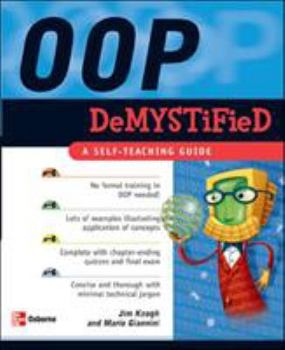OOP Demystified
Select Format
Select Condition 
Book Overview
Learn object-oriented programming in no time with help from this easy-to-understand guide, ideal for novice and expert programmers alike. Discover why objects are so successful as the model for this type of programming and how objects are classified. Distinguish between how people see the world and how computers "see" it. Learn about attributes and methods, inheritance, polymorphism, real-world and case modeling, object-oriented programming languages,...
Format:Paperback
Language:English
ISBN:0072253630
ISBN13:9780072253634
Release Date:March 2004
Publisher:McGraw-Hill Companies
Length:260 Pages
Weight:1.14 lbs.
Dimensions:0.6" x 7.4" x 9.2"
Customer Reviews
5 ratings
Really useful
Published by Thriftbooks.com User , 17 years ago
OOP demystified along with The object-oriented thought process are mandatory to start with oop. Not boring, with clear examples. The final part comparing java, c++, c# is really nice so you can get a basic idea on the main diffences between these famous languages.
They deliver!
Published by Thriftbooks.com User , 17 years ago
If you don't even know what OOP stands for then get this book! By the end of this book you will have a pretty good grasp on objects and inheritance and polymorphism and encapsulation! If you don't know C++ at all though I'd recommend reading the C++ Demystified book right before you read this one.
Great high level companion book
Published by Thriftbooks.com User , 18 years ago
For someone leaving the world of procedural programming, and getting into project management of an object oriented project, this was just what I needed. The syntax details are not prevelant -- look for that in another source. This book was mostly concept, including the basics, the differences from procedural programming, and common bugs and how to avoid them. It also advised common-sense, real world solutions in cases where OOP results in unneccessarily complex structure.
Very good OOP book - concise, clear, and brief
Published by Thriftbooks.com User , 20 years ago
I especially like reading Ch 8 -- Real-World Modeling. Not like all OOP books I read so far that the author will 'hard-sell' OOP as the best approach and by far better than procedural languages by simply demonistrating a small function and small application as to convince the readers. The author in this book is so honest to point out the SKILLS needed to apply the OOP theory into a [workable and useful] BUSINESS application, and the difficulties the developers will surely encounter in REALITY when using OOP. This is helpful if business organization are thinking of using OOP as their solution rather than the 'already proven sounding' procedural languages and relational database in the business environment.
Very good tutorial and review book on OOP...
Published by Thriftbooks.com User , 20 years ago
Target AudienceDevelopers who need an introduction to or a review of object-oriented programming.ContentsThis is an easily digestible tutorial on object-oriented programming (OOP) that can be used as an introductory or review text.The book is divided into the following chapters:A Look At How We See The World; What Is a Class?; Encapsulation; Methods and Polymorphism; Inheritance; Abstraction; Identifying and Describing Objects; Real-World Modeling; Collaboration; Case Modeling; Interfaces; Object-Oriented Programming Languages; Final Exam; Answers to Quizzes and Final Exam; Classes In Java; Classes In C++; Class Definitions In C#; IndexReviewMy career as a programmer started in the world of Cobol. Because of that experience, I tend to think of programming in terms of procedural coding. When I got ready to make the jump to Java and object-oriented programming (OOP), I had a difficult time getting my mind wrapped around OOP concepts. The explanations of "an object is like an airplane" didn't cut it for me, because an airplane wasn't code. I needed something that explained the concepts from a coding perspective without trying to teach you a language at the same time. I would have done much better had OOP Demystified been around back then.OOP Demystified is an approachable tutorial on OOP concepts for someone who doesn't come from that type of programming background. Each chapter explains a concept, shows examples from a Java and C-style coding viewpoint, and then ends with a test so that you can see if you've absorbed the material. If you've never seen Java or C code, the examples might be a little confusing, but not so much that you'd lose track of what's being discussed. The tone is conversational, so the barriers to learning are lowered.An additional benefit to this book over earlier attempts is that the authors include Unified Modeling Language (UML) concepts as the book progresses. UML is the standard way of diagramming OOP systems, and programmers need to understand the basic methodology. While not a "teach yourself UML" course, the reader will pick up enough information to be able to work in that environment. The material will also allow you to move on to a more focused UML tutorial with little effort.Even if you're not a complete novice to OOP, you will still benefit from having this book on your shelf. If you're like me and still have to think through the concepts on a regular basis, this volume will provide you with a quick refresher on the basic concepts that you can quickly review as needed. That's where my copy of this book will get most of its use.ConclusionIf you're getting ready to dive into the world of Java or C#/C++ and you don't have a background in OOP, this will give you a good foundation of the concepts you'll need. And if OOP isn't your primary background, you'll appreciate it as a refresher guide in order to cement specific concepts.





